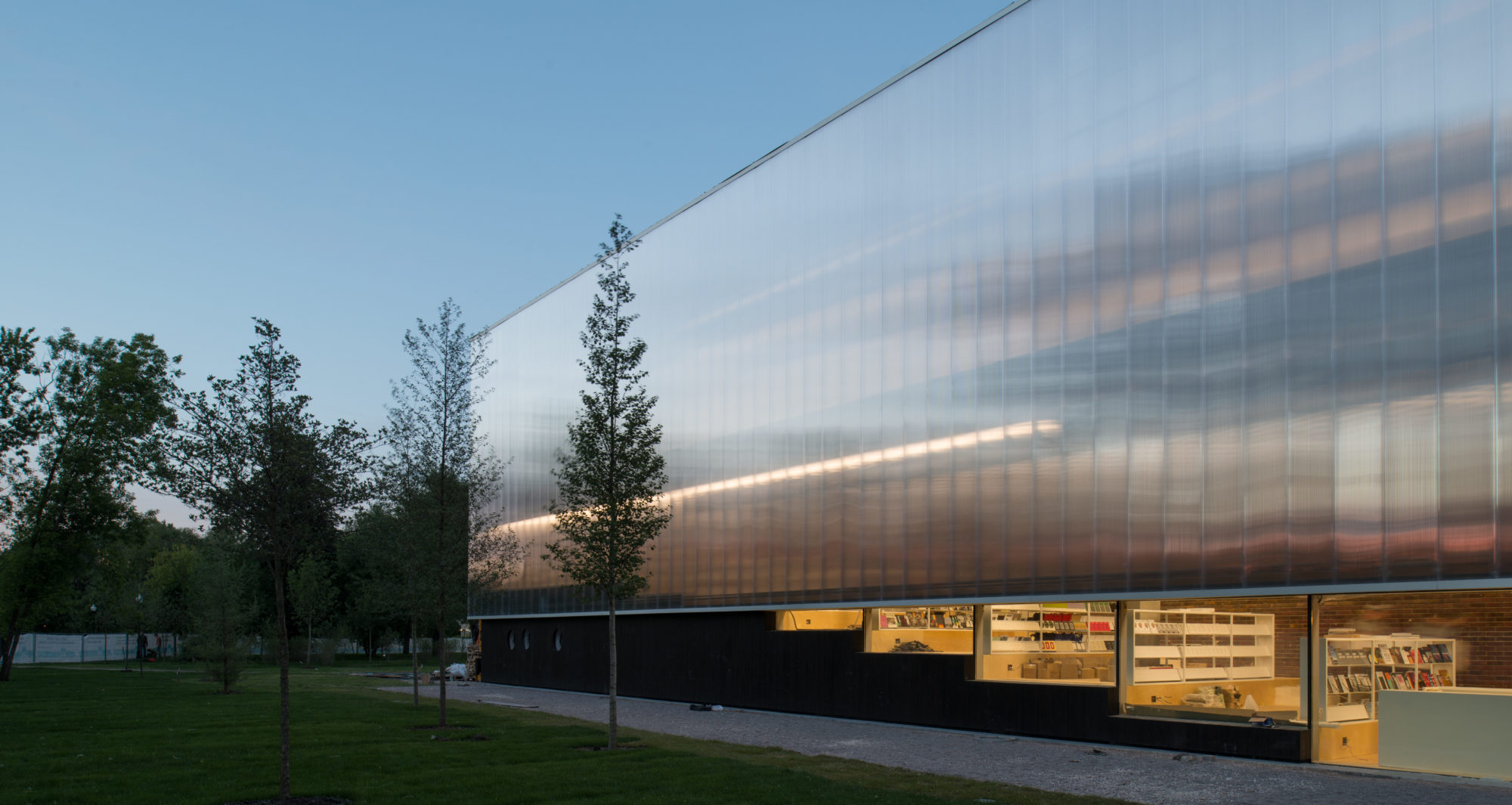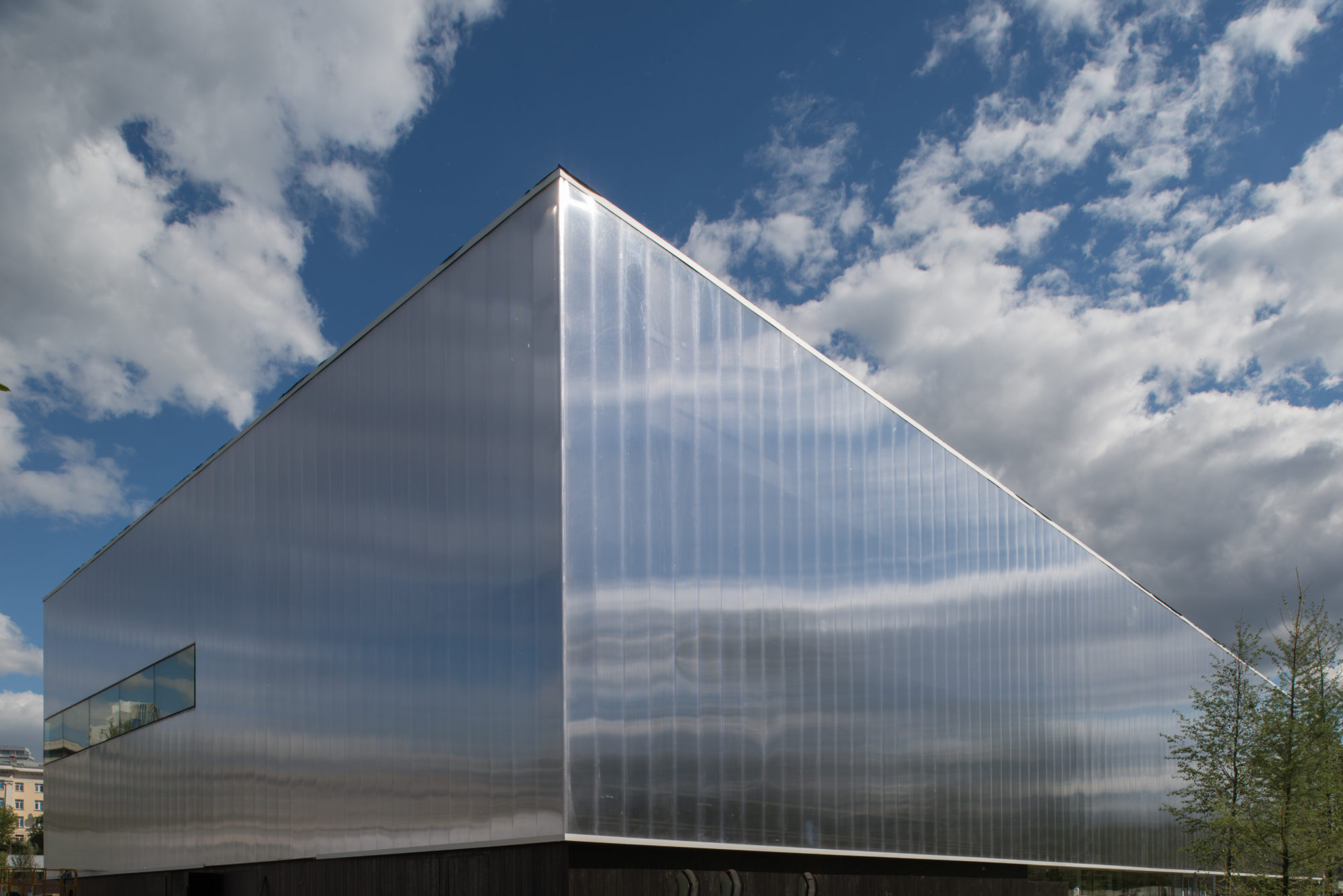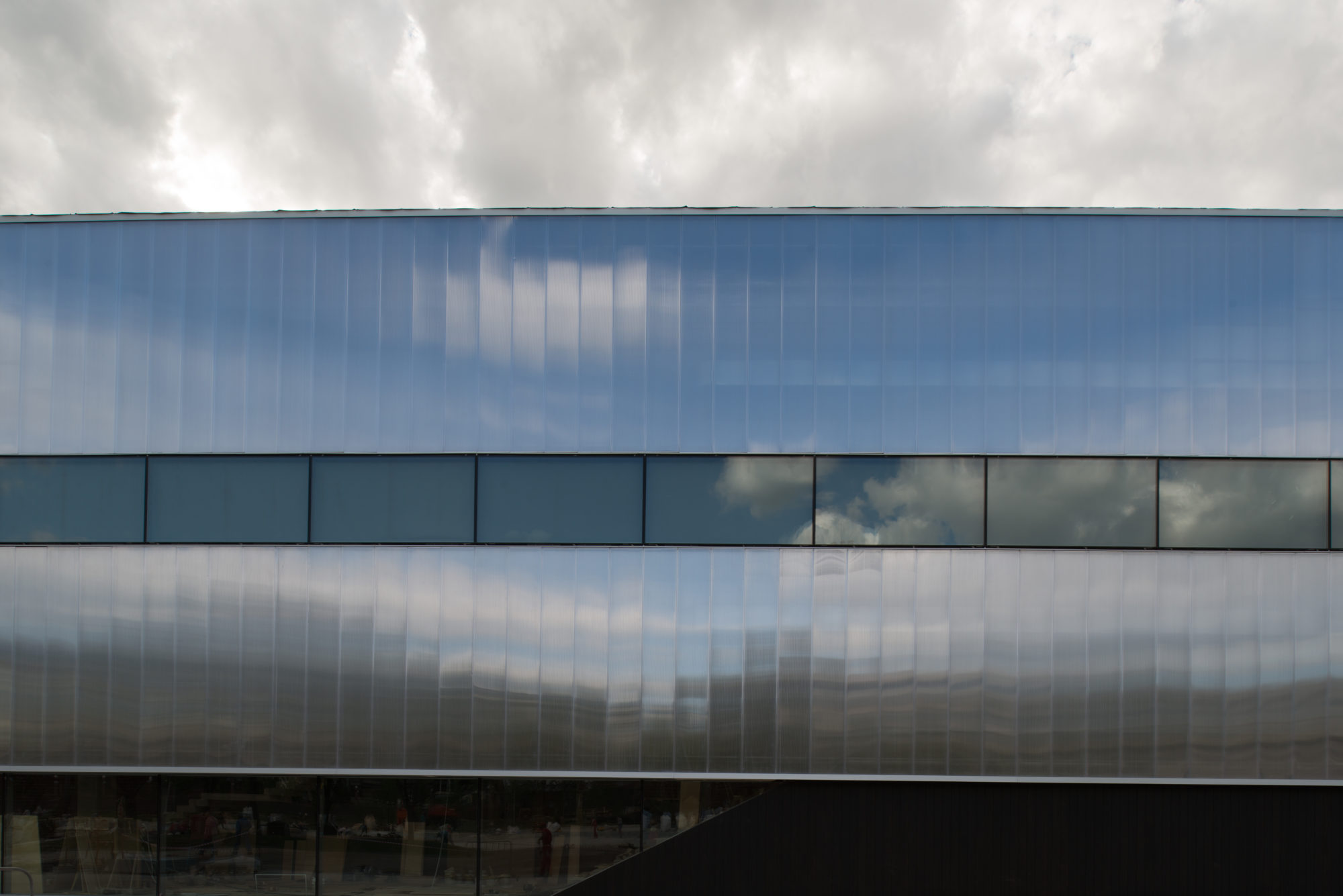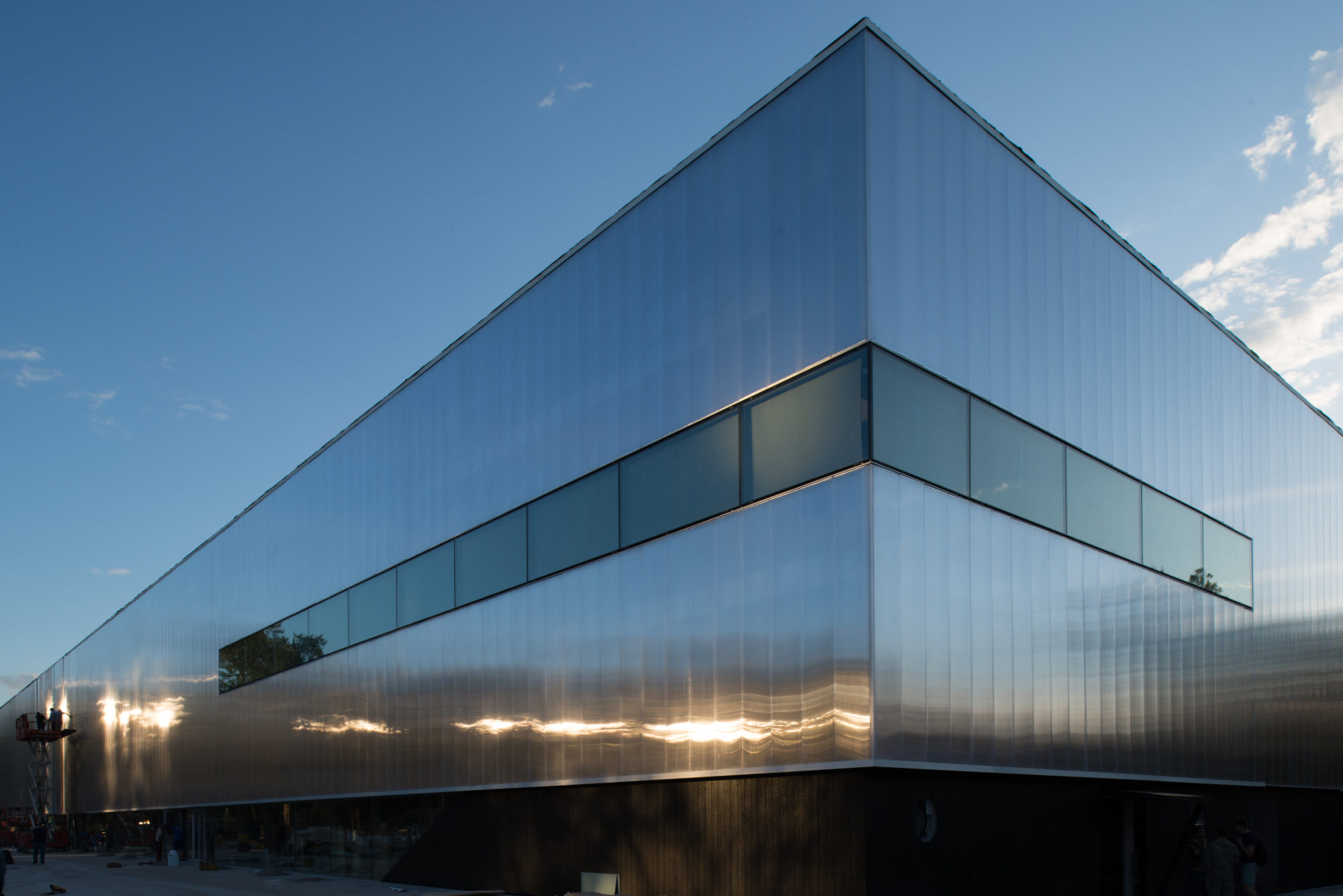
Garage Museum of Contemporary Art [photo: Yuri Palmin © Garage Museum of Contemporary Art]
Garage Museum of Contemporary Art
Share:
In 2008, Dasha Zhukova founded a museum inside the Bakhmetevsky Bus Garage in Moscow. The building, designed by the constructivist Konstantin Melnikov, gave the museum its name—Garage Museum of Contemporary Art—though the institution moved to Gorky Park in 2012, where for several years it was housed in a temporary pavilion by Tokyo architect Shigeru Ban. Its permanent space opened in June 2015; designed by the Office for Metropolitan Architecture, the building is a place for exhibitions and public and educational programming, as well as an ambitious and unusual historical preservation project for the city of Moscow: the renovation of a 1960s restaurant that had been derelict for two decades, along with its Soviet-era mosaic mural.
Garage is the first organization of its kind in Russia, and is a pioneer not only in its programming and architecture, but also in the scope of its mission: the museum is quite literally writing the book on public engagement, diversity, sustainability, accessibility, and philanthropy in the region, though the models it builds will be applicable globally. At the helm of this civic-minded test center are director Anton Belov, who trained to be a scientist and was co-founder of Moscow’s ARTGUIDE; and chief curator Kate Fowle, who is also director at large at Independent Curators International in New York, former international curator at the Ullens Center for Contemporary Art in Beijing, and co-founder of the master’s program in curatorial practice at the California College of the Arts (CCA), San Francisco. I spoke to Belov and Fowle during the opening week of Louise Bourgeois: Structures of Existence: The Cells (September 25, 2015-February 7, 2016), a historic presentation of Bourgeois’ work that brought her nine-meter-tall bronze spider, Maman(1999), to a public piazza in Gorky Park. Exhibiting this spring are Taryn Simon and Rashid Johnson, two American artists commissioned by Garage to create new, site-specific works in Moscow. Both projects represent career watersheds —Johnson’s installation is his largest to date; Simon’s is her first “live” production—which is an apt reflection of Garage’s penchant for breaking new ground.
Garage Museum of Contemporary Art [photo: Yuri Palmin © Garage Museum of Contemporary Art]
Victoria Camblin: What difficulties are you encountering as [part of] an institution that is really pioneering this kind of accessibility-oriented programming in a region where local and national government have done so notoriously little in that area?
Anton Belov: No other museum is doing the work we do for deaf or blind or disabled people. If you’re in a wheelchair, it’s impossible to get to the Pushkin Museum. When we started the program in 2014, we sort of tackled one thing a week, but by summer 2015, we had begun to do so many different things that it became its own department. More than 500 deaf people visited Garage last month—maybe it’s a really small [number], but it’s a community that can now visit and benefit from sign language interpretation, and communicate with others. What we found at first was that it was difficult to market the program, because this is a very close, sometimes isolated community. So we hired people with disabilities, too, who really know how to respond to certain needs.
VC: So you had to do that groundwork—the community resources just weren’t there?
AB: Exactly. That’s why we’ve also done master classes and public conferences for people working within other institutions. Russia has some unique problems that nobody else has, but at the same time we’re checking out similar issues that have been addressed around the world—some museums work more with the blind, some with the deaf, some with those in wheelchairs, and we’re looking at everything. We’ve also started a program with autism. We always try to find a partner institution that has the expertise, but we’ve found that to be difficult, too—again, you need connections to your community. After our disabilities conference in September, we decided to print a book, including international literature on the topic, translated into Russian, because we want to support change in other Russian museums, too, to make it possible to have a cultured life. Over the next several years we plan to work with institutions to change their perception of disability … it’s not a “problem”; it’s about engaging people.
VC: The museum is a social role model in this sense, too.
AB: We’re really invested in infrastructure, and in sustainability, and we’re working to educate people. We’re not only working on contemporary art—we’re changing society’s culture. We also publish 25-30 books every year.
VC: In-house?
AB: We have partnered with a publishing house, but it’s Garage’s program. We’ve translated Susan Sontag’s On Photography, the diaries of Andy Warhol—important works on contemporary culture that just weren’t available before.
Garage Museum of Contemporary Art [photo: Yuri Palmin © Garage Museum of Contemporary Art]
VC: Do you feel like you’re filling in the gaps in educational programming? How do you survey the quality of these initiatives—the rigor of all these different programs when there are so few models for what you’re doing?
AB: Garage has about 180 employees, but that’s including security, reception, and so on. We also have consultants and an advisory board; we have a strong network. For example, we’re also doing grants for young artists. Anyone can apply, and we choose seven artists to get a stipend of $500 every month for a year, so they actually have the time to make art. We couldn’t make an art school—we didn’t have the resources or the expertise—but we can do other things to support artists. We’ve also got 25 educational programs aimed at children, the elderly, families.
VC: Is the goal to institutionalize more? “The Garage School of Contemporary Art”?
AB: Maybe in the future. For now, we’re coming into our own as a serious institution; we have a collection, a comprehensive archive of Russian art, a library, professional training programs. We have 3,000 archival videos, 50,000 documents—artist [correspondence], personal archives—and a photo database. We realized there was a demand for this, and made the library open to the public in 2014; now it’s always full of scholars, journalists, from all over. So we’re building out more space. We have a professional archivist and an art historian running it and providing research help, and you can copy or scan anything for free.
VC: So, in every way you’re interested in access—in terms of physical access as well as access to information and ideas. What are your priorities for the near future? Are you feeling it’s been a success in terms of audience numbers?
AB: I think so, yes. We had 100,000 people here over the summer, and I imagine for 60%, 70%, it’s their first time coming to a museum of contemporary art. Now we’d like to learn how the building works. We have built a platform, but at the same time we feel things have changed so quickly—Moscow has changed, Russia’s culture institutions have changed, and we have to adapt very quickly to these things. It’s hard to say, we’re focusing on Russian art history or public programs. And because we’re having to build so much from scratch, right now we’re doing a lot of things that, in the future, we may not need to do anymore.
Garage Museum of Contemporary Art [photo: Yuri Palmin © Garage Museum of Contemporary Art]
Victoria Camblin: From your very international curatorial perspective, what’s it like interacting with Moscow, and working in Russia, in the sense that you’re basically building an infrastructure and an audience here, more or less from scratch? Do you ever feel you’re in a diplomatic role?
Kate Fowle: It’s interesting just to talk a bit about the diplomatic in general—we’re not just talking about Russia here, we’re talking about the internationalization of the globalization of the art world. When the “biennial” started in [the] 1990s as a kind of new foundation, artists outside … the Western axis of Europe and the US could start to speak for themselves for the first time. One of the books we’re putting out this fall is called Exhibit Russia, looking at 15 key exhibitions from 1986 [to] 1996 that connected Russian artists to the international art world, and vice versa. The 1990s is the opening up. There’s a number of larger-scale institutions and curators from the US and Europe that began to literally use cultural diplomacy. 10 Plus 10 was an exhibition that opened at the Corcoran in Washington, DC, at that time—literally, 10 American artists and 10 Russian artists. With Garage I think we need to come up with a different kind of word—a way around saying “one from here and one from there.”
VC: It sounds very bureaucratic.
KF: Yes—and traditionally, that is how internationalization has started! But I think post-2000, there’s another way. Our generation is not so interested in these diplomatic missions; we’re much more interested in informal networks and connections. There’s definitely this interconnectivity between people. When Dasha first set up Garage, she wanted to produce a kind of platform here for international art because it wasn’t being shown. Then, as it was developing in 2010 and 2011, that’s when it shifted into an institution that was homegrown.
VC: Perhaps it’s also about ambassadorship. You’re representatives of the “new Moscow.” Is the city itself supportive? Are its institutions aware that this level of quality of cultural programming is beneficial in terms of the sustainability of Moscow’s development?
KF: There is a ricochet effect, a kind of zeitgeist—a changing of the guards happening here, even. I think Dasha had a feeling that it was finally possible to do something that wasn’t possible before, and she was one of a number of people to feel that. The state-run institutions [take] longer to change, but they’re doing it in parallel. People see that Garage has the international connectivity that everybody else likes; we can collaborate on shifting audiences through connections to the state. We can attract people who think they’re not interested in contemporary art—you know, it’s much more popular to go to the contemporary theater or dance. So it’s a laboratory, really—it’s not just about making an exhibition program, and that’s it.
Garage Museum of Contemporary Art [photo: Yuri Palmin © Garage Museum of Contemporary Art]
VC: You’re working with a currently very private model, with such a public mission. How do you negotiate that?
KF: One of the first things I did when I came to Garage was talk to Adam Weinberg, who is the director of the Whitney Museum of American Art. The Whitney started in the 1930s, but it took 30 years for its founder to take that institution from literally a family-run institution to having a board. I think the board of trustees thinking in the American structure is really important because that’s when it basically is saying people will come together and share the responsibility toward the public. There’s actually a tradition of philanthropy in Russia, going back to the Imperial era, which is actually much higher than other European countries’. And now—slowly—we’re seeing people with means wanting to invest back into their country and culture again.
VC: First you have to buy the Prada bags and go to Nobu, and then you go back to the museum and to the homeland.
KF: Which is exactly the same as the United States! I moved from the UK to the United States in June 2001. Then 9/11 happened within a few months of me being there. I was teaching at CCA in the curating program at the time, and what I witnessed over the next decade was the rise of nationalism in the United States, and the counter effect of that with young Americans petrified that they were going to not be able to travel abroad because they would be seen as Americans, and that would be a really embarrassing tale. What you’ve basically got here is something that I see as a complete parallel—nationalism and protectionism, and a younger generation that’s not interested in that, but that also wants something to be proud of, part of a new Russia.
VC: You were here on the ground when you had Rem Koolhaas and OMA come and do the building, and that’s of course a project that really considers the site of the building, and the building itself—it’s a cultural archive. You’re also in a very public park; you’re kind of encroaching on it. Speaking of the Whitney, they’re very much engaged with New York [by] that new building, with its floor-to-ceiling windows and views of the High Line infrastructure ….
KF: It’s a backstage, front-stage version of the museum. This building is very much two-sided: it was built in 1968, by Soviet modernists; later, following the fall, a kind of international architectural style started to happen. Of course, this international style of … modernism is not something that the average person is actually interested in—people in general are much more interested in the classical architecture. So, for a local audience, it’s actually a very unusual experience to walk into a building of this kind. It’s not the kind of architecture that is usually preserved, because it was a restaurant, a quotidian architecture.
VC: There’s literal accessibility: physically getting people in the building, making things they can touch or smell or experience even if they have a disability that doesn’t usually get catered to by museums. But then, this other more nuanced question of accessibility, in terms of content … as a curator who’s worked in risk-taking environments, how do you approach keeping a high bar in terms of rigor and challenging your audience, and yet creating situations that aren’t alienating?
KF: This has been an issue in museums around the world. When I first started working in the 1990s in the UK, “Art for All” became the slogan of the Arts Council England. Suddenly you were getting funding according to audience numbers and diversity—disability especially. One of the ways to navigate this was simply to do work directly with artists who are interested in these issues. Jeremy Deller is a perfect example. Rather than trying to impose anything, you find artists who actually have a real interest in these subjects. You also have to take it seriously, really invest in thinking through audiences’ special needs, and work with important artworks. If you do that, it shifts the emphasis.
There’s a long way to go here—the research hasn’t even been done on blind or deaf populations, for instance, so you can’t say who you’re serving. Plus, you’re going to have to find them. But I think the other way of thinking about inclusion is to think about giving people something. You have to find a way to communicate that actually impassions people, regardless of the state of their mental or physical health. In a way, we’re the starting point, and what’s great is that you can do all the work that needs to be done alongside introducing people to contemporary art.
Victoria Camblin is ART PAPERS editor and artistic director.



